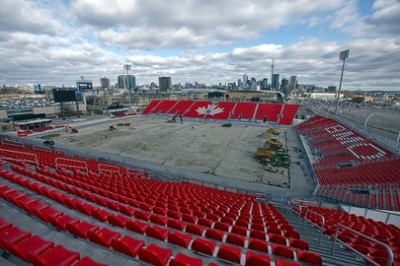
Should taxpayer dollars be used to finance infrastructures like sports stadia? Economists tend to say no. The implication here is that they won’t get built, as its notoriously hard for private entities to finance them. Peter Magowan was able to do it for the San Francisco Giants due to the region being awash in Silicon Valley money in the late 1990s, but it’s unlikely this could happen today.
The City of Toronto was part of a public/private venture that built and managed the Sky Dome {now Rogers Centre}. Sadly, it was a comedy of errors with huge cost overruns that included the building of a luxury hotel and underpricing of luxury skyboxes and advertising rights. The Sky Dome costs mushroomed to $570M CAN in 1989 and the project was saddled with huge debts. Despite the Blue Jays doing well attendancewise and the venue being booked for large concerts and home of the CFL Argonauts, the revenues weren’t enough. By 1994, the Ontario New Democratic Party government, who inherited the financial headaches from the Ontario Liberal government in power before 1990, paid off the debt and sold the venue for $151M to a private consortium. The venue went into bankruptcy protection in 1998 and in 2005, Rogers Communication bought and renamed the facility for $25M. Talk about depreciation.
In contrast, the Major Soccer League’s Toronto FC home, BMO Field cost $62M CAN with $44.8M coming from public sources in another public/private partnership. Built in 2007, BMO Field is now turning a small profit and Toronto FC attendance has been strong, so strong that there’s talk of expanding the 20,500 seat facility. The capacity was restricted when building BMO Field to maintain an intimate setting that was specifically designed for soccer.
Is there a moral to this story? A big part of the equation is realistic expectations of costs/revenues and good management. Nevertheless, even if it may not make “economic sense” to use public money to build these venues {in terms of jobs, tax revenues, increased business activity}, are there other reasons why taxpayer money should be used to build them?
An argument could be made that Toronto is a better city for having BMO Field or the Sky Dome/Rogers Centre, but for different reasons. BMO Field is bringing soccer to a diverse city, full of people who can relate to soccer. The Rogers Centre, like the Air Canada Centre used by the Toronto Maple Leafs {NHL} and Raptors {NBA}, signify Toronto’s place as a city by being a signifier of North American capitalism. The city is the largest in Canada and seventh in North America. Like it or not, being home to major sports teams gives the city status through media exposure and corporate marketing. The Buffalo Bills {NFL} have played games here, hinting that the first non-US NFL franchise may be Toronto and could use Rogers Centre, although there are potential stumbling blocks. The mega concerts can be accommodated. Despite it now being 21 years old, it still is iconic as place-as-spectacle, with its opening roof and downtown locale.
Freud would have had a field day with the opening and closing Sky Dome/Rogers Centre being next to the phallic CN tower.
Does it make sense for cities to invest in stadia? I don’t think it’s strictly an economic decision and why cities still invest in them is better explained by sociology. While public funds can be spend a myriad ways, how they will be spent has everything to do with the local political and economic actors. This book, Public Dollars, Private Stadiums, shows that these decisions to finance stadia can circumvent the will of the people, showing the power of embeddedness.
As for success of these public/private ventures, that’s a managerial issue depending on the circumstances, the terms, oversight, local politics, and a city’s long-term prospects.
Twitterversion:: Should public funding be used 4 sports stadia? A look @ the Sky Dome/Rogers Centre history & the emerging BMO Field story. @Prof_K
Song:: Saint Etienne-“This is Radio Etienne”

Comments